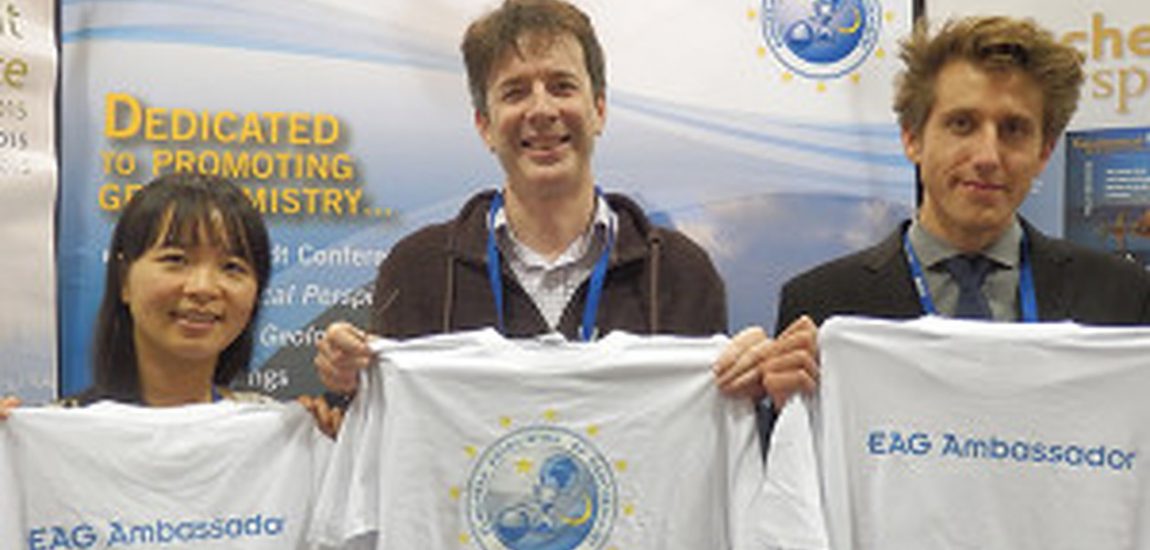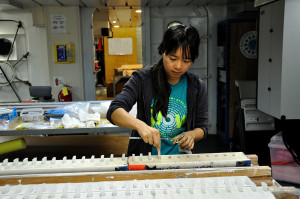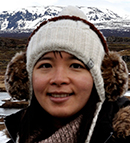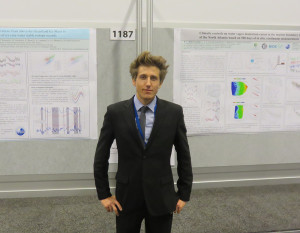
Two EAG Ambassadors at AGU Fall Meeting 2014

A few months ago, the European Association of Geochemistry (EAG) initiated the Early Career Science Ambassador Program, supporting Early Career Scientists based in Europe to attend conferences outside of Europe. Supported scientists have 50% of their expenses covered by EAG, up to 2000 Euros, and are viewed as EAG Ambassadors while attending the event. Ruifang Xie and Hans Christian Steen-Larsen were the first two EAG Ambassadors.
I greatly appreciate the EAG Early Career Science Ambassador Program, which funded my travel to attend the American Geophysical Union (AGU) Fall Meeting in San Francisco in December 2014. The Early Career Science Ambassador Program is a new initiative under the EAG to promote early career scientists’ participation at international meetings outside of Europe.
I was invited by Dr. Dirk Nürnberg from GEOMAR Helmholtz Centre for Ocean Research Kiel, the Primary Convener, to give a talk in the session “PP13D: Past Ocean’s Mode and Intermediate Water Variability II”. It is a rare opportunity for an early career scientist to be invited for a talk at one of the largest Geosciences conferences like AGU, which had nearly 24,000 attendees in 2014. I was excited to present new results from my last Ph.D. project that was newly published (Xie et al. Geochimica et Cosmochimica Acta (2014) 140: 455-467). Meanwhile, it was encouraging to receive all the positive and helpful feedbacks, showing others’ interests in my research. Leading scientists from similar fields in this session also presented thought-provoking results, which triggered dynamic discussion even after the end of the session.
Despite its busy daily schedule, the AGU Fall Meeting provides a unique platform to meet and network with fellow scientists, funding agencies, and policy makers from different parts of the world. I enjoyed meeting new friends and future collaborators. I also served in the scientific panel as a judge for the poster presentation throughout the week. The experience I had at AGU last year was one of the best.
In sum, the Early Career Science Ambassador Program not only provided me with financial aid to dissimilate scientific results, but also offered me an opportunity to expand my network that is crucial for any early career scientist. I want to thank EAG’s generous support and would highly recommend the Early Career Science Ambassador Program to my early career fellows.
About the author
Biogeochemistry Department at the Max Planck Institute for Chemistry. Her research involves using radiogenic and stable isotope tracers, as well as trace metals, from deep-sea sediments and seawater to study the relationship between global climate and ocean circulation, atmospheric circulation, marine biogeochemical cycling, and continental aridity and hydrology over recent Earth history.
Water vapor is the most potent greenhouse gas. Despite the importance of water vapor in the climate system and its influence the Earth’s future climate there are still many processes, which are poorly understood and characterized. Water vapor isotopes (the relative abundance of heavy isotopes 1H218O and 1H2H16O compared to the light and most abundant isotope 1H216O) offer the possibility to improve our understanding and characterization of the physical processes controlling the atmospheric hydrological cycle. The differences in the molecular structure of the individual water isotopes give rise to differences in the vapor pressure and molecular diffusivities through air. Hence, equilibrium and kinetic fractionation will occur at each phase transition resulting in the atmospheric water isotopes becoming an integrative tracer for the ambient conditions, which an air mass has experienced. Previously scientists have been limited by the large amount of work involved in getting the isotopic composition of the water vapor. However, it is now possible, thanks to the evolution in the commercial spectroscopy analyzers, to observe continuously in-situ the atmospheric water vapor isotopic composition. This analytical revolution now allows us to understand and characterize the processes of the atmospheric hydrological cycle.


The support of the European Association on Geochemistry’s Early Career Science Ambassador Program allowed me to present my work on observing and understanding the atmospheric water vapor isotopic composition, which I have been carrying out since 2010 as an early career scientist. At the American Geophysical Union Fall meeting in December in San Francisco I presented two posters: Using Water Vapor Isotope Observations from above the Greenland Ice Sheet to improve the Interpretation of Ice Core Water Stable Isotope Records and Climatic Controls on Water Vapor Deuterium Excess in the Marine Boundary Layer of the North Atlantic Based on 500 Days of in Situ, Continuous Measurements.
This work covered field campaigns in Greenland focusing on the processes controlling how the climatic fingerprint was recorded by the ice core isotope values, and field campaigns in the Bermuda Islands, where a completely autonomous water vapor isotope analyzer has measured continuously the marine boundary layer water vapor isotopic composition since the Fall of 2011.
While it might seem that these two studies is not directly related they are indeed related as the study in the Bermuda Islands focuses on improving our understanding of how the source region conditions influences the isotopes of the water vapor, which later falls as snow on top of the Greenland Ice Sheet. Understanding how the conditions in the source region influences the atmospheric water isotopes will allow scientists to improve the ability to deduce paleo-climate variations over the ocean from ice core isotope records.
There are still research to be done but progress is being done continuously by the community.
About the author
Hans Christian Steen-Larsen is a postdoctoral fellow at Laboratoire des Sciences du Climat et de l’Environnement, France. H. C. Steen-Larsen’s main scientific expertise is associated with the use of stable water isotopes to understand the physical processes of the atmospheric hydrological cycle and how the climate is imprinted in the isotopic fingerprint. He uses this knowledge to deduce past climatic variations from ice core water isotope records.

